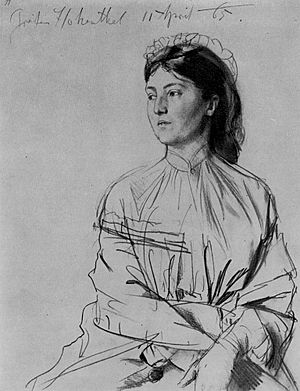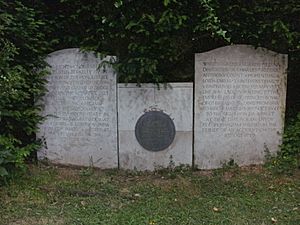Walburga, Lady Paget facts for kids
Quick facts for kids
Walburga, Lady Paget
|
|
|---|---|
 |
|
| Known for | Lady-in-waiting to Queen Victoria |
| Born | Walburga Ehrengarde Helena, Countess von Hohenthal 3 May 1839 Berlin |
| Died | 11 October 1929 Newnham on Severn |
| Spouse(s) |
Augustus Berkeley Paget
(m. 1860; died 1896) |
Walburga Ehrengarde Helena, Lady Paget (born Walburga von Hohenthal; May 3, 1839 – October 11, 1929) was a German writer. She was also a close friend of Queen Victoria.
Contents
Walburga's Early Life and Family
Walburga Ehrengarde Helena von Hohenthal was born in 1839 in Berlin, Germany. Her parents were Count Karl Friedrich Anton von Hohenthal and Countess Emilie Niedhart von Gneisenau. Before she got married, Walburga worked as a lady-in-waiting for Victoria, Princess Royal. A lady-in-waiting is a female assistant to a queen or princess.
In 1860, she married Sir Augustus Berkeley Paget (1823–1896). He was a British ambassador. An ambassador is a top diplomat who represents their country in another nation. Sir Augustus worked in many places, including Copenhagen, Vienna, and Rome.
Walburga's Children and Royal Connections
After her husband moved to Copenhagen for his job, Lady Paget helped Queen Victoria. She helped arrange the marriage of the Prince of Wales, who later became Edward VII, to Princess Alexandra of Denmark.
The Pagets had three children:
- Victor Frederick William Augustus Paget (1861–1927), who became a Lieutenant Colonel in the army.
- Alberta Victoria Sarah Caroline Paget (1863–1944), who married Robert Windsor-Clive, 1st Earl of Plymouth.
- Sir Ralph Paget (1864–1940), who also became a diplomat.
Life in Italy and Later Years
In 1867, her husband was sent to Florence, which was then the capital of Italy. When Rome became the capital in 1870, Lady Paget helped set up the British embassy there.
Later, in 1887, Lady Paget rented a beautiful house called Villa Caprini in Fiesole, Florence. In 1893, when her husband retired and moved back to Britain, she bought another house called Torre di Bellosguardo.
After her husband passed away in 1897, she continued to live at Bellosguardo. She spent her time working to protect old parts of Florence from being destroyed. She also worked on her house and gardens. Queen Victoria even visited her in 1893.
In 1913, Lady Paget returned to Britain because of rumors of war. She passed away in 1929 at the age of ninety. She died after an accident by the fire at Unlawater House, Newnham on Severn. She was buried next to her husband in Tardebigge, Worcestershire.
Walburga's Views on Vegetarianism
Lady Paget was a vegetarian. She wrote an article called "Vegetable Diet" in a magazine in 1892. She explained why she chose not to eat meat.
She felt that eating meat was wrong after reading about how animals were transported and killed. She believed that people should not enjoy things that make others do jobs that are harsh or unkind. She also thought that a plant-based diet was the healthiest choice.
However, Lady Paget did eat eggs and fish. She also enjoyed a glass of wine with dinner, so she did not agree with the idea of avoiding all alcohol. She once said that her diet made her feel "a delightful sense of repose and freedom." Lady Paget was also a vice-president of the London Vegetarian Society.
Walburga's Published Works
Lady Paget wrote several books, mostly about her life and experiences. Some of her published works include:
- Vegetable Diet (1892, republished in 1893)
- Colloquies with an Unseen Friend (1907)
- Scenes and Memories (1912)
- Embassies of Other Days (1923)
- In My Tower (1924)
- The Linings of Life (1929)


